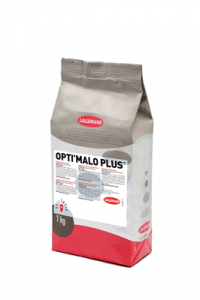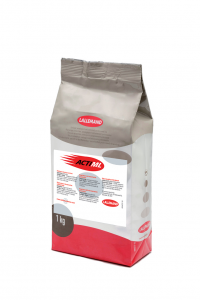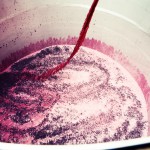Timing your malolactic fermentation
You’ve decided you want your wine to undergo MLF. But when should it happen?
There are a couple different schools of thought on this. You can either add the bacteria so it happens simultaneously with alcoholic fermentation (“co-inoculation”) or after it has completed (“sequential inoculation”).
What’s the purpose of MLF?
The process of converting harsh malic acid into the softer lactic acid is easy to do and can alter the wine significantly. It changes not just the amount and type of acid present, but how the wine is perceived overall. While this conversion can happen on its own without your intervention, it is highly recommended that you inoculate with a chosen malolactic bacteria in order to best ensure everything remains healthy and in balance from start to finish.
Whether you choose to co-inoculate or do it sequentially is completely up to you – both are acceptable! Either way, you just want to be sure that your juice/must is balanced and undergoing (or underwent) a healthy fermentation, to better guarantee the health of the subsequent MLF. The preparation of the malolactic bacteria will be the same regardless of when it gets added. Some require a rehydration period and some can be added directly to the wine. Some are liquid and some are in freeze-dried form. Acti-ML nutrient and Opti-Malo are a helpful additives to use to help the conversion reach completion without any issues. Think of Acti-ML and Opti-Malo as the equilivent of Go-Ferm and Fermaid K, but for malolactic bacteria.
Why should I do co-inoculation?
- MLF generally completes more quickly with this method due to:
- higher temperatures thanks to alcoholic fermentation being underway
- lower alcohol levels at the onset of MLF
- higher nutrient levels
- You won’t need to use an external heat source
- SO2 can be added earlier on in the wine’s life since MLF is completing sooner
Are there any benefits to waiting until after alcoholic fermentation has finished?
- Some believe that ML bacteria and yeasts will be fighting for the same nutrient sources, adding a potential layer of stress
- Ability to focus on one conversion at a time
I’m deciding to wait to add ML bacteria because that’s what I’ve always done.
OK, that’s fine too! If you’re choosing this route, then wait until the Brix has dropped to about 5.
Are there any downsides to waiting to add ML bacteria?
- The wine is unprotected from SO2 for a longer period of time since you can’t add SO2 until MLF is complete.
- You will likely need to use external heat sources to keep the wine warm enough to finish MLF in a timely manner. This means more labor and energy expense.
- Higher alcohol levels can slow the speed of ML conversion or even stop it completely.
Overall, the benefits of co-inoculation seem to outweigh any benefits of the sequential method. Of course, if you have a preference and it works for you, that’s all that matters. As long as your fermentation and ML conversion are happy and healthy, you’re good to go!
What else can I do for a good MLF?
A chosen ML bacteria + proper temperature + good nutrition + not overadding SO2 = a recipe for healthy MLF. Whether you co-inoculate or add toward the end of AF is up to you and your preferences. Regardless of which option you choose, using paper chromatography to track the process is always recommended.
Are you used to sticking to one method and want to give the other a shot? Stop in and ask a Musto Wine Grape Company employee for some help making the switch over!
The Winemaker’s Think Tank: Vol 22 – Seven Most Common Winemaking Mistakes
What’s the Winemaker’s Think Tank?
Every Thursday we will post about a few frequently asked questions that our winemaker has answered. If you have a winemaking question you would like to have answered, please email us at support@juicegrape.com and we will try to get into next week’s post. Cheers! 🙂
Seven Most Common Winemaking Mistakes
1. Headspace – When making wine, it is imperative that any vessel being used is filled completely. Filling carboys, demijohns, or fixed capacity tanks to the highest level possible, minimizing any air space it very important to prevent oxidation. If using a barrel, the barrel will allow for some evaporation as the wine ages. It is critical to top of the barrel with additional wine as this will prevent the oxidation of the wine in the barrel. Barrels do promote a small amount of oxidation, referred to as micro-oxidation, which is helpful at creating a creamier mouthfeel and promoting the expression of fruit flavors and aromas. If a large headspace develops due to evaporation, this can cause severe oxidation in the wine.
2. Degassing– Carbon dioxide gas is a byproduct of the yeast during alcoholic fermentation. Often times the bubbles of SO₂ are so small, they get trapped by the weight of the wine. If the wine is not purposefully degassed, the bubbles may come out of solution in the bottle, resulting in a fizzy wine for the drinker. The degassing process is relatively simple. One may purchase a degassing tool that is attached to a cordless power drill and stirs the wine at a high speed, agitating it and releasing the trapped bubbles. The winemaker can also splash the wine while racking, agitating the wine and releasing the trapped bubbles of gas. As long as the wine has been stirred vigorously, the gas should dislodge and escape, ensuring that it will not be fizzy in the bottle.
3. Sanitation – This may be the most important step in all of winemaking. While cleaning and sanitizing may be a tedious and time consuming process, it is critical to ensure a healthy, long lasting wine. There are an assortment of cleaning agents (B-Brite, Soda Ash, Sterox) that are excellent at cleaning wine making equipment and removing stains. These products need to be rinsed off thoroughly and should be thought of as “soap” rather than sanitizer. After the equipment has been washed and well rinsed, it must then be sanitized with potassium metabisulfite. A solution of 2 ounces of sulfite powder, dissolved into one gallon of water, will yield a strong sanitizing solution that will kill off any microbes that could spoil the wine. This will ensure the longevity of the wine in the aging vessel or bottle.
4. Bench Trials – When using a fining agent or oak additive to your wine, it is very important to first conduct a small trial of the product, before adding it to the entire batch. Assess the addition rate for the compound you would like to add to the wine. Using that as a guide for your ratio, pull out a small amount of the wine and add the compound, making sure that the ratio is accurate for that size sample. Allow the sample to sit for a few days and try it. If the results are what you were striving for, then you can apply the compound to the entire batch. This will help save you time and money if you are not satisfied with the results of the bench trial and will help you most effectively improve your wine.
5. Sulfites – Sulfites are a naturally occurring compound within wine. While sulfites do exist naturally, they are at a low level, not sufficient for helping to preserve the wine as an antioxidant. Additional potassium metabisulfite must be added to help prevent oxidation as well as prevent any advantageous microbes from growing in the wine. If the winemaker neglects to add sulfites to the wine, it will easily oxidize and could also be susceptible to bacterial contamination.
6. Record keeping – Often times with winemaking, “the devil is in the details”. The smallest change in yeast strain, nutrition, and grape acid and sugar content, can have dramatic effects on the resulting wine. The best winemakers, on the home or professional level, take meticulous notes on all of their activities and observations. By keeping track of each step of their process, they are able to reproduce their very best wines and also do research on what went wrong with their failures.
7. Timing – It is said that timing is everything. This is particularly true for winemaking. Many folks assume after fermentation, they can just leave the wine alone to age and it will come out beautifully if untouched. This is not the case. The wine needs to be maintained with racking and sulfites to ensure its longevity. Sometimes in winemaking, a fault may develop, Rather than researching a way to fix the fault or seek some professional advice, some winemakers elect to do nothing and hope the fault goes away. Often times, these faults progress and get worse. If caught early, they can be easier to fix.
We hope this information helps with your winemaking. If you have any follow up questions or winemaking questions in general, please email us at support@juicegrape.com.










Recent Comments